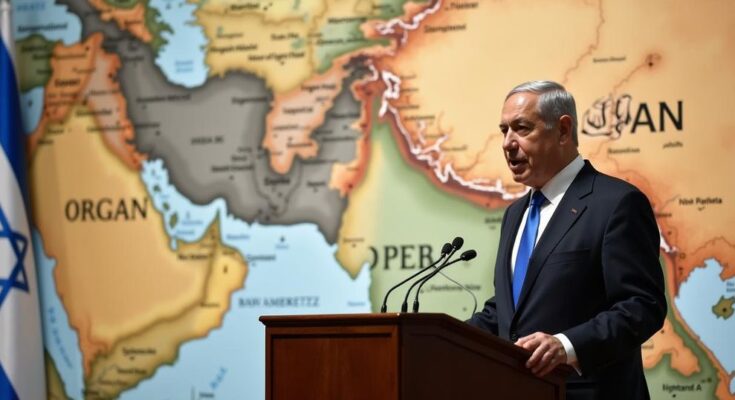In his recent UN General Assembly address, Israeli Prime Minister Benjamin Netanyahu presented two maps to symbolize the contrasting influence of India and Iran, referring to India as a ‘Blessing’ and Iran as a ‘Curse’. He expressed concerns regarding Iran’s role in regional terrorism and promoted Israel’s partnerships with Arab nations for future economic collaboration, while asserting Israel’s right to defend its security against threats from Hezbollah and Iran.
During the recent United Nations General Assembly session, Israeli Prime Minister Benjamin Netanyahu made a significant impact with his remarks aimed at portraying the contrasting roles of India and Iran in regional geopolitics. Netanyahu presented two maps: one labeled as the ‘Blessing’ map, which highlighted India, Egypt, Sudan, and Saudi Arabia, and another referred to as the ‘Curse’ map, showing Iran, Iraq, Syria, and Yemen. In his address, Netanyahu emphasized that the ‘Curse’ map illustrated an arc of terror stemming from Iran, which he claimed has destabilized regions from the Indian Ocean to the Mediterranean. He stated, “Iran’s malignant arc has shut down international waterways. It cuts off trade, destroys millions of nations from within, and inflicts misery on millions.” Conversely, the ‘Blessing’ map represented the potential for collaboration and economic progress through partnerships between Israel and its Arab allies, aiming to establish a land bridge that would facilitate trade and communication between Asia and Europe. Netanyahu proclaimed, “Across this bridge, we will lay rail lines, energy pipelines, and fiber optic cables, which will serve the betterment of 2 billion people.” He alerted the audience that Iran’s influence is not confined to the Middle East but poses a broader global threat, stating, “Iran seeks to impose its radicalism well beyond the Middle East and that is why it funds terror networks on five continents and builds ballistic missiles for nuclear warheads to threaten the entire world.” Addressing potential misconceptions regarding Israel’s position, Netanyahu clarified that the issues surrounding Iran and Hezbollah were of paramount importance and that Israel would take necessary actions to ensure the safety of its citizens while counteracting these threats, stating, “Israel will continue degrading Hezbollah until all their objectives are met.” He also expressed his intention to correct the narrative surrounding Israel and noted that his presence at the UN was meant to challenge the ‘lies’ and ‘slanders’ directed at his country. Netanyahu’s rhetoric underscores the ongoing friction between Iran and Israel and highlights Israel’s strategic alliances, relying on imagery and metaphorical language to convey his message of hope versus despair.
The context of Benjamin Netanyahu’s address lies in the broader geopolitical struggles faced by Israel, particularly as it concerns the influence of Iran in the region and beyond. Over the years, Iran has emerged as a significant regional power, often characterized by its support for various militant organizations, including Hezbollah and Hamas. This perceived threat has led Israel to seek stronger alliances with neighboring countries, such as India and those in the Arab world, to counteract Iranian influence and promote stability. Netanyahu’s use of visual aids during his speech is a strategic approach to simplify complex geopolitical dynamics for the audience, aiming to rally support against Iran’s alleged aggressive policies.
In summary, Prime Minister Netanyahu’s depiction of India as a ‘Blessing’ and Iran as a ‘Curse’ during his UN address served to emphasize the contrasting trajectories and roles that these nations play in the geopolitics of the Middle East. His speech reflects ongoing tensions and the need for international cooperation to address security threats posed by adversarial entities such as Iran. As Israel continues to navigate its challenges, the emphasis on potential partnerships with likeminded nations will be crucial for its strategic vision moving forward.
Original Source: www.livemint.com




